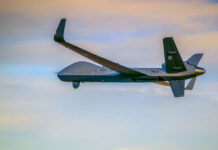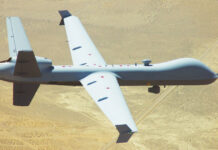General Atomics Aeronautical Systems Inc (GA-ASI) has conducted its first flight test series of the Gray Eagle Extended Range (GE-ER) unmanned aerial vehicle (UAV) using a Proliferated Low Earth Orbit (PLEO) satellite constellation for aircraft communications, the company announced on 12 March 2025.
Contracted by the US Army, the flight tests began in January 2025 and make the GE-ER the first US Army aircraft to be controlled over the new satellite service. The Gray Eagle is also the only US Army UAV capable of leveraging geostationary Earth orbit (GEO), low Earth orbit (LEO) and PLEO constellations for secure, in-flight adaptable and resilient communication, navigation and data management, GA-ASI noted.
The initial testing focused on flight-critical operations, including core aircraft control functions as well as sensor and communications systems. To date, GA-ASI has conducted two GE-ER flights and a series of ground test events using PLEO. Future flight testing is in the planning stages and includes operations across the full flight regime.
The Gray Eagle family of UAVs is built on a Modular Open Systems Approach (MOSA) design that includes standardised interfaces and protocols. This approach has enabled rapid integration of the PLEO constellation and other significant capabilities without major technical efforts or extended timelines for integration and testing so new capabilities can be fielded faster.
“The PLEO integration and flight testing continue to show that the current GE-ER open architecture is real,” GA-ASI’s vice president of Army Programs, Don Cattell, was quoted as saying in a company press release. “We are practicing rapid integration now, which will prove critical to the platform’s survivability and mission success in multi-domain operations.”
Building on the GE-ER, the Gray Eagle 25M (GE 25M) “takes MOSA to the next level with a government-owned/government-controlled open architecture that enables plug-and-play capabilities to ensure the platform’s rapid, low-cost adaptability to changing threats”, GA-ASI stated. The GE 25M incorporates an open-architecture approach with its ground systems, advanced and modular datalinks, and an upgraded propulsion system, enhancing the platform’s ability to rapidly add new capabilities, provide resilience to electronic threats and deliver expeditionary employment to austere locations. PLEO will be a baseline capability for the Gray Eagle 25M.
The PLEO capability for the GE 25M is just one of several features of the system that maximises the survivability of the platform. It also provides a low- cost opportunity to drastically increase the operational flexibility of both the Gray Eagle ER and Gray Eagle 25M. The GE 25M’s MOSA architecture enables use of the higher data rates available on the PLEO system and supports flight operations worldwide. These capabilities, combined with longer-range sensors, anti-jam navigation, and expeditionary ground control systems, allow Gray Eagles to operate outside the envelope of threat weapon systems but still deliver effects hundreds of kilometres beyond the forward line of own troops, which GA-ASI says makes the GE 25M the most survivable aircraft in the US Army inventory.




![Developments in strike UAVs The Flyby Jackal launches an LMM during testing. [Crown Copyright 2023]](https://euro-sd.com/wp-content/uploads/2025/07/Jackal_Crown-Copyright-Kopie-218x150.jpg)







